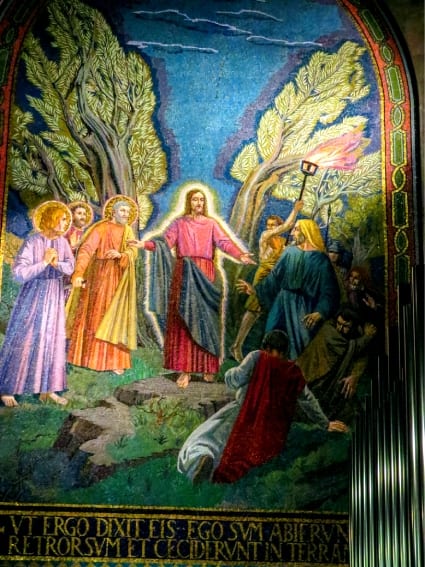The Church of All Nations, also known as the Church of the Agony, is located on the Mount of Olives in Jerusalem, next to the Garden of Gethsemane. It enshrines a section of bedrock where Jesus is said to have prayed before his arrest. (Mark 14:32–42)

The History of the Church of All Nations
On the site of the church stood a small Byzantine basilica built in the fourth century and destroyed with the Sassanid conquest in 614 CE. In the 12th century, a much larger Crusader church was built on the site, but it was abandoned and destroyed no later than 1347. Then in 1919, Antonio Berluzzi was appointed to make the current church. In 1920, a year after the work began, a pillar and a mosaic section from the Byzantine church were exposed, and the construction work ceased until 1922. Upon completion of the archaeological research conducted by Gaudenzio Orfali, the church plans were changed and completed and dedicated in 1924.

The Byzantine church was probably built during the reign of Emperor Theodosius I (379-395); it is mentioned in the writings of St. Jerome in the 4th century and of the pilgrim Agrias in the 5th century. A layer of destruction (by massive fire) was found, probably from the Sassanid occupation of the Holy Land in 614, and except for a single mention of St. Willibald from the 8th century, there are no reliable descriptions of a ritual structure that inhabited the site until the Crusader period.

The Crusader Church of the Agony
At the beginning of the 12th century, after a silence of about 500 years concerning the history of the place, pilgrims wrote that there was a small church on the site. This may have arisen during the period of tolerance that characterized the Fatimid rule during the 11th century. In the middle of the 12th century, the small church was replaced by a church larger than it and the ancient Byzantine church.

After the conquest of Jerusalem by Saladin in 1187, the evidence about the church ceased, and it may have been destroyed. In 1323 the existence of a church was reported again at the site, and apparently, this report reconciles with two different types of columns found on the site. This church, whether it was the original Crusader church or another church, was later destroyed in 1347.
The Modern Church of All Nations
The modern Church of All Nations was built on the longitudinal axis of the Byzantine Church. However, its dimensions are much larger and closer to the Crusader Church’s. The cornerstone was laid in 1919, and the task was entrusted to the architect Antonio Barluzzi. The church was completed in 1924. The church’s ceiling and the mosaic of the Eastern Wall incorporate the symbols of the 16 countries whose contributions helped build the church. Including Argentina, Brazil, Chile, Mexico; Italy; France; Spain; England, Belgium, Canada, Germany, the United States, Ireland, Hungary, Australia, And Poland.

Due to the international character of the church, it was decided to establish it in the Roman-Classical style typical to the time of Christ. Barluzzi sought to express in the building the grief that befell Jesus during the agony in Gethsemani. So, therefore, the church’s interior is semi-dark.
The Italian Hospital in Jerusalem

In addition, its ceiling is relatively low, and 11 low domes are set against the 11 apostles and a large dome representing the crucifixion. The predominant color in the pieces of alabaster incorporated into the walls of the building is purple, the color of mourning in the Christian tradition, and the star-studded mosaic ceiling is painted dark blue.

Last Things About the Modern Church
Around the stars that mimic the night sky of mourning, olive branches are incorporated to represent the nearby Getsemani trees. The natural rock combined in the original Byzantine church has been preserved and integrated along the Eastern Wall. The building stone in shades of reddish-gray was brought from the nearby quarries and incorporated into the inner walls of the building.

In contrast, its outer walls were decorated with pinkish stone from the Bethlehem area. In addition, the structure is divided into three passages that are identical in size, and between them are two rows of thin pink columns, which give the hall the appearance of one ample space. The single apse is set at the eastern end of the central aisle.

The foyer opens to the Kidron Valley through three arches of identical dimensions; columns bearing Corinthian capital heads are between them. In addition, the statues of the four Evangelists stand on the pillars between the arches and in the corners of the building. The huge gable above the foyer is a mosaic depicting Jesus as the mediator between God and humanity. Jesus is seen in crimson, the color of the kingdom, having given his heart to the angel on our right hand.

More About the Mosaic
Two groups of people stand on either side of Jesus. But at some distance from him to emphasize his loneliness during his sufferings in Gethsemane. Now the people on the right are the common people; they are weeping and mourning. While those on the left represent those in power and the wise like the Jewish priests; choosing not to recognize Jesus as Christ and the Gospel (one of them is holding a book with the word “ignorance” on it). But Jesus accepts the requests of all human beings, as the verse below the scene testifies:
“During the days of Jesus’ life on earth, he offered up prayers and petitions with fervent cries and tears to the one who could save him from death, and he was heard because of his reverent submission.”
Hebrews 5:7

